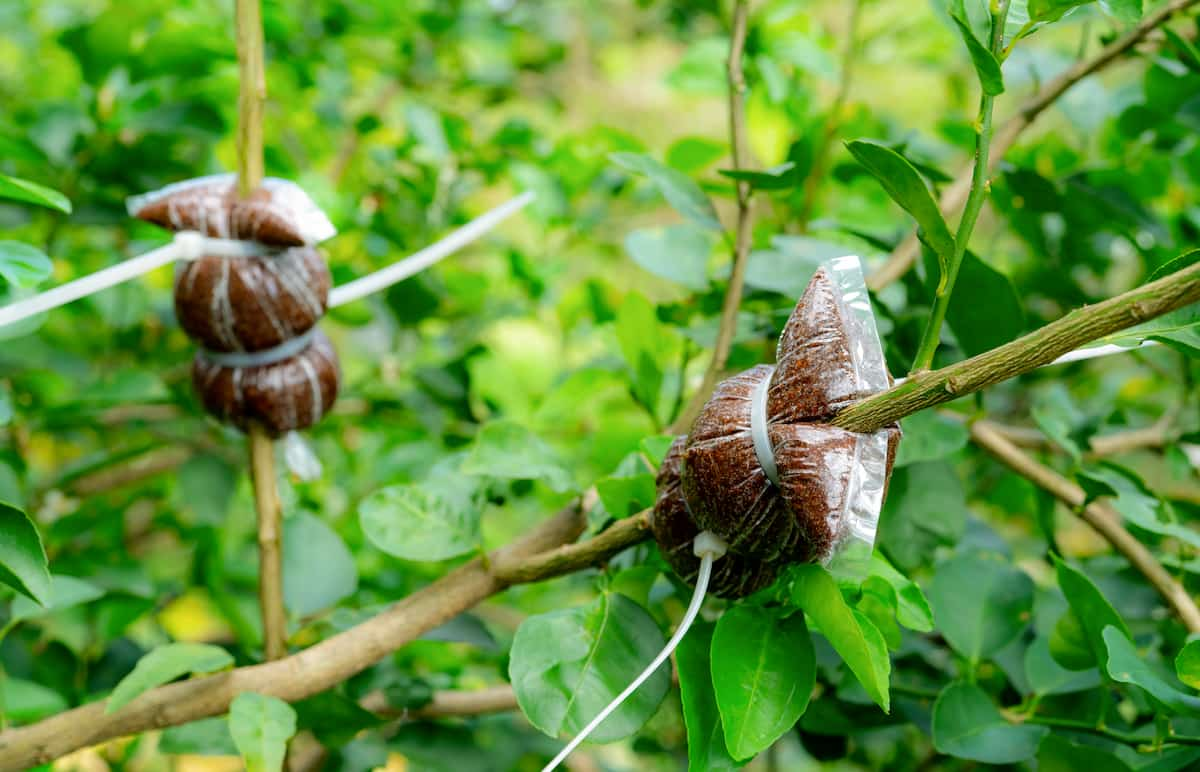Plant propagation can be accomplished in a variety of ways. The simplest method is to use seeds, which often take months or even years to mature. Additionally, plants grown from seed are not always identical to their parents. You need genetic material to create an identical copy. Basically, you use the plant itself. By layering, you can produce new plants that are genetically parallel to the parent, which will carry all of the characteristics of its parent. Air layering is one of the most commonly used methods of layering.

Air Layering Propagation Process
Plants Grown By Air Layering
Traditionally, air layering has been used to propagate woody shrubs, creepers, and trees. Propagation by this method is well-known for flowering shrubs such as Bougainvillea, Hibiscus, Tabernaemontana, and Magnolia. Air layering also successfully propagates foliage plants such as Ficus, Crotons, and Aralia. Layering is the best method for propagating fruiting trees like citrus, mangoes, and guavas.
Steps For Plant Propagation By Air Layering Using Ring/Sleeve Method
- Choosing a shrub or tree with medium-sized branches is the first step.
- Choose a healthy, non-flowering branch that is neither too young nor too old.
- Cut off most of the old, mature leaves at the portion of the branch where layering will take place.
- Remove the bark ring (3-5 cm) in a circular motion and expose the inner tissue at an appropriate distance.
- Using a painting brush, apply rooting hormone to the wound.
- Cover the wound using wet sphagnum moss that has been soaked in water.
- Cover the moss with polyethene paper & tie it on either side by a thread. This will keep the moss in place. It should resemble a toffee wrapped in a wrapper. A Gootee is what this structure is called.
- For aeration, make incisions on Gootee with the blade.
- Depending on the species, roots will begin to form in 2-3 weeks or 1-2 months. From the Gootee, you can see the tips of young roots.
- The branch and roots should be detached once the roots have formed.
- The layered branch should be transplanted into soil, pots, or polybags as a sapling.
- Placing a polyethylene tent over the newly potted plant for 4 to 8 days is helpful until the roots have established well. This will prevent excessive moisture loss.
- To encourage the growth of the new root system, keep the plant under a light shade and away from direct sunlight for a few weeks.
Air Layering By Tourniquet Method
The tourniquet method involves wrapping copper wire tightly around the trunk/branch to partly block nutrients from flowing. As the trunk/branch grows thicker, the nutrients will decrease, forcing the roots to grow above the wire. This method is used for trees with a slow growth rate and needs more time to develop new roots than aggressive ring methods. Several tree species are suitable for the tourniquet method, including maples, junipers, pines, azaleas, and elms.
- Wrap copper wire around the trunk or branch right at the point where new roots should grow.
- Wires should be thick enough to cut halfway into bark; the wider the trunk/branch, the thicker the wire.
- Wrap some sphagnum moss around the wound and cover it with plastic after dusting some rooting hormone on it.
- Then the next steps that need to be followed to grow a new plant is as the same as the sleeve/ring method.
Follow-Up Care After Air Layering
You may need to add a few drops of water to the rooting bundle if it appears to be drying out. For roots to appear, it may take between one and three months. Before detaching your cutting from its parent plant, it should be at least two inches long and showing through the moss. To do so, cut its stem just beneath the roots with a knife or pruning shears and remove any plastic wrapping or film. The new plant should be potted while the moss remains in place.
In case you missed it: Homemade Fertilizer for Fruit Trees

You will need to keep the plant out of direct sunlight and cover it with plastic suspended over the plant with stakes for about a week. You can then gradually expose the plant to lower humidity by punching holes in the “tent.” Don’t forget to leave your air layering bundles up in the air.
What is the Best Time of Year to Propagate via Air Layering?
Air layering can be done either in spring or in mid-summer. Choose shoots from the previous year’s growth if you can do your air layering in spring. You can select shoots from the current year if you don’t get to propagation until midsummer. Shoots on woody outdoor trees should be no larger than a pencil and 3/4 inch in diameter. Those on “softer” indoor plants can be much larger than that. If so, consider making two small alternating slits instead of one long cut.
Common Problems When Air Layering
The application of air layering is very safe as long as it is done correctly. Clear sleeves cause problems when you attempt air layering on a slow-growing species. In this case, solid-colored sleeves should be used instead of see-through ones.
The reason is that algae grow in damp environments exposed to light, which may slow the growth rate of new roots or even kill them. Creating wounds that are too shallow or leaving too much cambium (cellular plant tissue) on the target area is another real problem associated with failed air layering. This results in slow root growth or no root growth at all.
Advantages of Air Layering
- With air layering, far less work is required than with other propagation techniques
- Both parent plants and clones benefit from new growth
- As opposed to years, full-size trees can be created within weeks or months
- The parent tree or plant is not damaged
- Plants and trees cloned by air layering have a high success rate
- Creating identical copies of parent plants is possible
- Faster and stronger root development than other methods
In case you missed it: Frequently Asked Questions About Irrigation

What Plants Can Not Be Air Layered?
The majority of plants can be air layered, but there are a few that cannot. Air layering is difficult for conifers, for example. In most cases, conifers don’t respond well to air layering, but with a green thumb, a bit of luck, and just the right conditions, they can be air layered. Some plants cannot be air layered successfully, including:
| Azalea | Forsythia |
| Camellia | Jasmine |
| Chaenomeles | Philodendron |
| Daphnes | Rhododendron |
| Ficus |
Conclusion
Experts have reported a 90 percent success rate for air layering. A good-sized plant can be grown in weeks instead of months or years, and even beginners can use this method to grow the best houseplants. Little skill, effort, or equipment is required for air layering, and it is relatively simple. Additionally, it can be used to propagate plants that mature into woody stems, which would be difficult to propagate otherwise.
- Ultimate Guide to Ossabaw Island Hog: Breeding, Raising, Diet, and Care
- Ultimate Guide to Juliana Pig: Raising Facts, Size, Diet, Care, and Lifespan
- Raising Lleyn Sheep: Disadvantages, Price, Uses, Characteristics, and Care
- Ultimate Guide to Meishan Pig: Breed Facts, Breeding, Raising, and Care
- Ultimate Guide to Teacup Pigs: Raising, Diet, Lifespan, Cost, and Care
- Guide to Raising Poll Dorset Sheep: Facts, Profile, Characteristics, Uses, and Care
- Ultimate Guide to Bighorn Sheep: Characteristics, Diet, Lifespan, Breeding, and Lifecycle
- Ultimate Guide to Raising Katahdin Sheep: Farming Facts, Breed Profile, Uses, and Care
- Ultimate Guide to Raising Oreo Cows: Belted Galloways Farming Facts, Profile, Uses, and Care